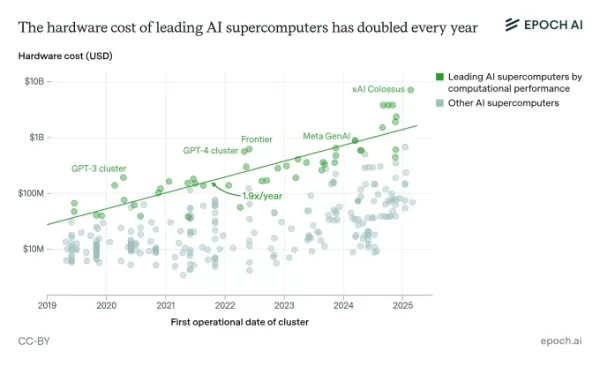AI Data Centers May Cost $200B by 2030, Strain Power Grids
AI training and operation data centers could soon house millions of chips, cost hundreds of billions, and demand power equivalent to a major city’s grid if trends persist.
A new study from Georgetown, Epoch AI, and Rand researchers analyzed over 500 global AI data center projects from 2019 to 2025. The data shows computational performance doubling yearly, alongside soaring power demands and capital costs.
These findings highlight the challenge of building infrastructure to support AI advancements in the next decade.
OpenAI, with 10% of the global population using ChatGPT, has partnered with SoftBank and others to raise up to $500 billion for a U.S.-based AI data center network, with potential international expansion. Tech giants like Microsoft, Google, and AWS are also investing hundreds of millions this year to expand their data center infrastructure.
The study notes that hardware costs for projects like xAI’s Colossus, priced at $7 billion, have risen 1.9x annually from 2019 to 2025, with power needs doubling yearly. (Colossus consumes about 300 megawatts, equivalent to 250,000 households.)

Image Credits: Epoch AI While data centers have improved energy efficiency—computational performance per watt rising 1.34x yearly from 2019 to 2025—these gains won’t offset escalating power demands. By June 2030, a leading AI data center could require 2 million chips, cost $200 billion, and need 9 GW of power, comparable to nine nuclear reactors.
AI data centers’ growing energy demands could strain power grids significantly. A Wells Fargo analysis predicts a 20% rise in data center energy use by 2030, potentially overwhelming renewable energy sources and increasing reliance on fossil fuels.
Beyond energy, AI data centers raise environmental concerns like high water use, occupy valuable land, and reduce state tax revenues. Good Jobs First estimates that 10 states lose over $100 million annually due to generous data center tax incentives.
These projections may not fully materialize, or timelines could shift. Recently, hyperscalers like AWS and Microsoft have scaled back data center plans. Cowen analysts noted a “cooling” in the data center market in early 2025, reflecting concerns about unsustainable growth.
Related article
 Study Reveals Challenges in Obtaining Reliable Health Advice From Chatbots
As healthcare systems struggle with extended wait times and escalating costs, a growing number of patients are experimenting with AI chatbots like ChatGPT for preliminary medical advice. Recent data shows approximately 17% of U.S. adults consult thes
Study Reveals Challenges in Obtaining Reliable Health Advice From Chatbots
As healthcare systems struggle with extended wait times and escalating costs, a growing number of patients are experimenting with AI chatbots like ChatGPT for preliminary medical advice. Recent data shows approximately 17% of U.S. adults consult thes
 Study Reveals Concise AI Responses May Increase Hallucinations
Instructing AI chatbots to provide brief answers may lead to more frequent hallucinations, a new study suggests.A recent study by Giskard, a Paris-based AI evaluation firm, explored how prompt phrasin
Study Reveals Concise AI Responses May Increase Hallucinations
Instructing AI chatbots to provide brief answers may lead to more frequent hallucinations, a new study suggests.A recent study by Giskard, a Paris-based AI evaluation firm, explored how prompt phrasin
 AI-Powered Solutions Could Significantly Reduce Global Carbon Emissions
A recent study by the London School of Economics and Systemiq reveals that artificial intelligence could substantially lower global carbon emissions without sacrificing modern conveniences, positionin
Comments (2)
0/200
AI-Powered Solutions Could Significantly Reduce Global Carbon Emissions
A recent study by the London School of Economics and Systemiq reveals that artificial intelligence could substantially lower global carbon emissions without sacrificing modern conveniences, positionin
Comments (2)
0/200
![WillieRodriguez]() WillieRodriguez
WillieRodriguez
 October 1, 2025 at 6:30:36 AM EDT
October 1, 2025 at 6:30:36 AM EDT
Putain ! 200 milliards de dollars pour des data centers AI ? 😳 C'est plus que le PIB de nombreux pays. On devrait peut-être commencer à construire des centrales nucléaires plutôt que des GPUs...


 0
0
![ScottJackson]() ScottJackson
ScottJackson
 September 3, 2025 at 12:30:37 PM EDT
September 3, 2025 at 12:30:37 PM EDT
AI 데이터 센터 전력 소비 문제, 정말 심각하네요... 2030년이면 서울 전체 전력량을 쓸 수도 있다니 🤯 재생에너지 확대가 시급한데, 실제로 가능할지 우려됩니다.


 0
0
AI training and operation data centers could soon house millions of chips, cost hundreds of billions, and demand power equivalent to a major city’s grid if trends persist.
A new study from Georgetown, Epoch AI, and Rand researchers analyzed over 500 global AI data center projects from 2019 to 2025. The data shows computational performance doubling yearly, alongside soaring power demands and capital costs.
These findings highlight the challenge of building infrastructure to support AI advancements in the next decade.
OpenAI, with 10% of the global population using ChatGPT, has partnered with SoftBank and others to raise up to $500 billion for a U.S.-based AI data center network, with potential international expansion. Tech giants like Microsoft, Google, and AWS are also investing hundreds of millions this year to expand their data center infrastructure.
The study notes that hardware costs for projects like xAI’s Colossus, priced at $7 billion, have risen 1.9x annually from 2019 to 2025, with power needs doubling yearly. (Colossus consumes about 300 megawatts, equivalent to 250,000 households.)

While data centers have improved energy efficiency—computational performance per watt rising 1.34x yearly from 2019 to 2025—these gains won’t offset escalating power demands. By June 2030, a leading AI data center could require 2 million chips, cost $200 billion, and need 9 GW of power, comparable to nine nuclear reactors.
AI data centers’ growing energy demands could strain power grids significantly. A Wells Fargo analysis predicts a 20% rise in data center energy use by 2030, potentially overwhelming renewable energy sources and increasing reliance on fossil fuels.
Beyond energy, AI data centers raise environmental concerns like high water use, occupy valuable land, and reduce state tax revenues. Good Jobs First estimates that 10 states lose over $100 million annually due to generous data center tax incentives.
These projections may not fully materialize, or timelines could shift. Recently, hyperscalers like AWS and Microsoft have scaled back data center plans. Cowen analysts noted a “cooling” in the data center market in early 2025, reflecting concerns about unsustainable growth.
 Study Reveals Challenges in Obtaining Reliable Health Advice From Chatbots
As healthcare systems struggle with extended wait times and escalating costs, a growing number of patients are experimenting with AI chatbots like ChatGPT for preliminary medical advice. Recent data shows approximately 17% of U.S. adults consult thes
Study Reveals Challenges in Obtaining Reliable Health Advice From Chatbots
As healthcare systems struggle with extended wait times and escalating costs, a growing number of patients are experimenting with AI chatbots like ChatGPT for preliminary medical advice. Recent data shows approximately 17% of U.S. adults consult thes
 Study Reveals Concise AI Responses May Increase Hallucinations
Instructing AI chatbots to provide brief answers may lead to more frequent hallucinations, a new study suggests.A recent study by Giskard, a Paris-based AI evaluation firm, explored how prompt phrasin
Study Reveals Concise AI Responses May Increase Hallucinations
Instructing AI chatbots to provide brief answers may lead to more frequent hallucinations, a new study suggests.A recent study by Giskard, a Paris-based AI evaluation firm, explored how prompt phrasin
 October 1, 2025 at 6:30:36 AM EDT
October 1, 2025 at 6:30:36 AM EDT
Putain ! 200 milliards de dollars pour des data centers AI ? 😳 C'est plus que le PIB de nombreux pays. On devrait peut-être commencer à construire des centrales nucléaires plutôt que des GPUs...


 0
0
 September 3, 2025 at 12:30:37 PM EDT
September 3, 2025 at 12:30:37 PM EDT
AI 데이터 센터 전력 소비 문제, 정말 심각하네요... 2030년이면 서울 전체 전력량을 쓸 수도 있다니 🤯 재생에너지 확대가 시급한데, 실제로 가능할지 우려됩니다.


 0
0





























